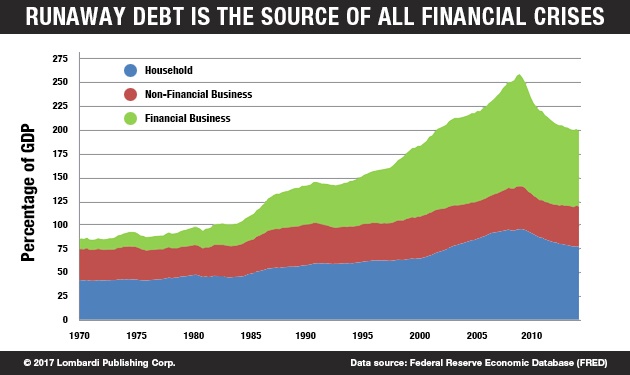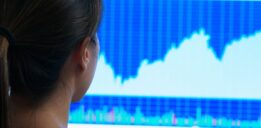Next Stock Market Crash Is Approaching and it Could Spell Economic Collapse
If the U.S. economy functioned like the weather, the stock market would be more predictable. Radar, barometers, and thermometers would more accurately show us what we can expect. Thus, investors could prepare accordingly, knowing whether they should bring an umbrella or wear a parka in the morning. Still, no radar is needed to predict a major financial storm, which could lead to an upcoming economic collapse.
There are a few developments from Washington and Wall Street that might approach the accuracy of a small weather balloon. The political situation in the United States is untenable. Trump cannot govern while the most bizarre investigation since J. Edgar Hoover was in charge of the FBI continues. Investors have bolstered Wall Street to record highs, but there’s no foundation to sustain those highs.
The stock market, the Dow Jones, and the NASDAQ have performed better than ever. Many publicly criticize Donald Trump, intimating that they would never have voted for him. Yet those same Trump detractors, in private, no doubt appreciate his promised tax cuts and investment incentives.
Also Read:
Stock Market Crash 2017? This Could Trigger a Stock Market Collapse
Warren Buffett Indicator Predicts Stock Market Crash in 2017
Basically, it’s as if the U.S. has become a runaway train, heading toward a fuel depot. If it sounds like the scene of a movie, it is, and a successful one at that. The reasons that thrillers work is that they allow audiences to experience extreme events. They feel the rush of emotions, fear, and the satisfaction of resolutions.
The Stock Market Is Now Like the First “Jaws” Movie
When thrilling events occur in real life, they’re less pleasant. Most investors prefer a quiet trading day with steady, if not great, gains while avoiding heart-stopping changes. Yet the markets—specifically Wall Street—now remind me of the first Jaws movie. Everything looks lovely on the surface. Investors are like the summer bathers, enjoying a swim or surfing a wave at the beach on a sunny day. They don’t see the danger that lurks beneath: the next stock market crash.
Investors on Wall Street appear to have forgotten all principles of trading, if they even learned them in the first place. The S&P 500 is trading some 25 times higher than earnings, on average. Now, the S&P 500 is a U.S. stock market index, but it’s the world’s main barometer of financial strength and market sentiment. It represents the aggregate performance of the 500 American companies with the greatest market capitalization. It cuts across just about every economic sector, and it has—clearly and by far—become the most trusted benchmark for the global stock market.
But, just as in the best thrillers, crises always happen when people aren’t paying attention. There’s a major risk of recession and economic collapse in 2017 because the markets are bursting. They are way overpriced, while the headwinds of chaos in Washington and the rest of the world are gathering momentum.
Noted Financial Guru Jim Rogers Has a Warning
Investment legend Jim Rogers is watching. Rogers, chairman of Rogers Holdings and Beeland Interests, Inc. His net worth is modest by the standards of investors of his ability. His former partner George Soros, with whom Rogers co-founded the Quantum Fund, is worth some $25.0 billion.
Rogers believes that, by 2018, the financial markets will suffer the biggest crash of our lives (unless you were born in 2009 or later). Rogers suggests that a bigger market crash than 1929 or 2008 could occur at any moment. (Source: “JIM ROGERS: The worst crash in our lifetime is coming,” Business Insider, June 9, 2017.)
Several factors could trigger a major market crash. They range from the collapse of the American pension fund system—a crisis receiving little attention these days—or the outbreak of a war (more on that below). But the main reason Rogers expects an imminent crash is that the market is in a bubble. The bubble will burst, and we should be very worried. (Source: Ibid.)
Recently, both European and American stock markets have been experiencing a phase of uncertainty which has not caused any major downturn. But, secretly perhaps, many investors must be experiencing a rising sense of fear about the sustainability of the current bull market.
Goldman Sachs has fired off a first salvo about the so-called FAAMG stocks. FAAMG is an acronym standing for five major U.S. technology companies: Facebook Inc (NASDAQ:FB), Apple Inc. (NASDAQ:AAPL), Amazon.com, Inc. (NASDAQ:AMZN), Microsoft Corporation (NASDAQ:MSFT), and Google (otherwise known as Alphabet Inc (NASDAQ:GOOG)). Goldman Sachs believes they and many fellow NASDAQ-listed stocks have inflated a huge bubble. (Source: “Tech stocks nosedive after Goldman Sachs report released,” New York Post, June 9, 2017).
Goldman Sachs is hardly alone. Other major banks, especially Bank of America Merrill Lynch, have intimated as much. Their fears have not made the headlines on CNN or CNBC yet, but the day of reckoning is near. Tech stocks are seen as especially vulnerable. As for the rest of the market, there’s too much uncertainty.
Yes, some stocks have been beating expectations. Some of the tech companies have market caps that have moved from utterly ridiculous to positively ludicrous. Yes, I’m looking at you, Tesla Inc (NASDAQ:TSLA). The NASDAQ, in fact, has started to show weakness, and the bubble it has inflated could burst at any moment.
The stock market has maintained an unsustainable pace of expansion. For a number of reasons, this cannot but end in a crash. If investors try to ease off the pedal gradually, analysts will call a market contraction. More analysts will point out that Wall Street is in a bubble, and it won’t be long before the market contraction becomes a stock market crash in 2017 or early 2018, as Jim Rogers expects.
Then there are some structural pitfalls to consider. The one that stands out like a hippo performing the Nutcracker ballet at Carnegie Hall is U.S. debt. By this I mean federal, state, municipal, personal, and corporate debt. This debt is one of the main reasons why growth has stagnated in recent years. This figure is currently at $66.0 trillion, or 330% of GDP. Servicing the debt means that valuable resources have had to move away from productive uses.
The World Is More Dangerous, so Invest Accordingly
Chief of all risks that could burst the bubble, triggering a massive financial crash, is the political situation in Washington. Trump has been weakened and diverted from his path. He’s being badly guided, and one of the effects of this is the possibility of a major war. That might leave some stocks in defense immune from crashing, but that does not take away from the fact that the markets are laden with risks, and that a major stock market crash is imminent.
The United States could stumble into a major conflict, potentially with Russia. Few stocks, or in fact people, would have much to celebrate about that.
Many stocks are banking on overly optimistic assumptions, but the fact that in June a Russian “Su-27 ” fighter jet with air-to-air missiles under its wings reached within feet of a U.S. Air Force “RC-135” in reconnaissance over the Baltic Sea should send investors to the exits.
This was but one of several interactions over the Baltic Sea region between American and Russian fighter jets and warships. Days earlier, the Russian Defense Ministry warned that any American jet flying west of the Euphrates River over Syria would be treated as a target after the U.S. Navy crashed a Syrian plane that hit anti-Syrian-government rebels aligned with the United States.
The Russian army has supported the Syrian government for decades. Since 2015, it has deployed its own forces, providing dozens of fighter planes and helicopters. In February, Russian fighter jets flew around U.S. Navy ships in the Black Sea, while the U.S. Army dumped dozens of tanks and 500 soldiers of its army in a port near Romania. Russia, as it happens, shares the Black Sea with Romania and other countries; some friendly, others less.
Meanwhile, instead of seeing the real risks that Washington and Moscow have gotten themselves into, U.S. Congress debates Trump’s alleged role in Russia hacking. They must have little else to do, it seems. Hostilities between Russia and the United States are reaching fever-pitch levels. Every day could be the occasion of another “Cuban Missile Crisis”-style confrontation.
Whereas in 1962, the risks were contained within Cuba, now the risks are in the Black Sea, the Middle East, and the Baltic. The markets haven’t noticed this for some reason; they’re too distracted by the FBI and CNN witch-hunts to notice the massive risk to the economy, not to mention life on earth, should sparks start flying beyond the rhetoric.
Indeed, the exaggerations are falling over themselves. Tom Clancy himself could not come up with a more gripping plot. About two months ago, the destroyer USS Porter fired Tomahawk cruise missiles into Syria, hitting Russia’s ally. Over the past few weeks, the U.S. military participated in a major military training exercise in the Baltic region, where long-range “B-52” and “B-1” nuclear bombers were deployed. Dozens of U.S. warships are taking part in Baltic Sea exercises, just west of Russia’s coast.
What can you do as an investor? Frankly, the question should be: “What can you do as a person to stop the madness?” But military tensions and wars build a machine-like momentum all on their own. Over a hundred years later, nobody really knows how World War I began. Even World War II is unclear; there are different explanations and timelines, depending on which historian you consult.








